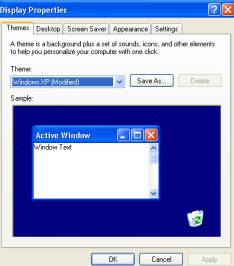
Desktop
On your computer monitor, the background behind all the windows, menus, and dialog boxes is referred to as the desktop. It is supposed to represent a desk, which explains why it is called a desktop.

![]() Icons
Icons
![]() When
you open a window on your desktop, several pictures will be displayed. These
pictures are called icons, and they can represent a file, directory, or action
for your computer. Placing the mouse pointer on the icon and double-clicking
will allow you to access the information the icon controls.
When
you open a window on your desktop, several pictures will be displayed. These
pictures are called icons, and they can represent a file, directory, or action
for your computer. Placing the mouse pointer on the icon and double-clicking
will allow you to access the information the icon controls.
![]() Program icon
Program icon
![]()
A program icon represents a software
package.
![]() File icon
File icon
![]()
A file icon represents a place to
store information created by a program or for use with that program.
![]() Folder icon
Folder icon
![]()
A folder icon represents a group of
programs and files
that you want to locate together.
The task bar is a strip that is usually at the bottom of your screen. From it you can launch programs, view the time clock, open the Start menu, and see icons for inactive windows (windows that are not highlighted).
![]() Locate
the task bar and icons on your desktop.
Locate
the task bar and icons on your desktop.
![]() Display
properties
Display
properties
You can change the appearance of your desktop by right
mouse clicking on the desktop, and then point to Properties on the popup
menu.

To see more settings, click the tabs at the top of the Display Properties dialog box.

![]() Open
the Display Properties dialog box, click on the Appearance tab and the
Background tab. Practice changing the appearance and background of your desktop.
Open
the Display Properties dialog box, click on the Appearance tab and the
Background tab. Practice changing the appearance and background of your desktop.
Introduction to Computers
Developed by Alyce Bunting, Jintavee Monsakul, and Donna Green
![]() Return to Introduction to Computers
Return to Introduction to Computers
dfgreen.com